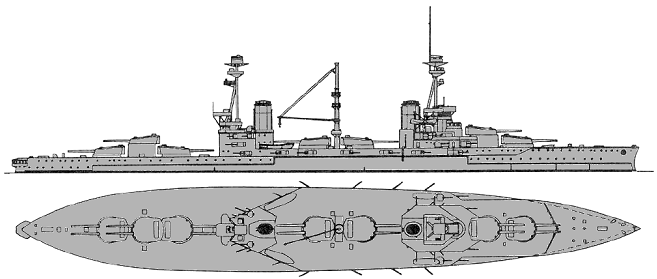

Agincourt 1915
| Name | No | Yard No | Builder | Laid down | Launched | Comp | Fate |
| Rio de Janeiro | Armstrong, Elswick, UK | 9/1911 | 22.1.1913 | 8/1914 // --- | sold incomplete to Turkey (Sultan Osman-i Evvel) |
|
Displacement normal, t |
27500 |
|
Displacement full, t |
30250 |
|
Length, m |
204.7 |
|
Breadth, m |
27.1 |
|
Draught, m |
8.20 mean |
|
No of shafts |
4 |
|
Machinery |
4 sets Parsons geared steam turbines, 22 Babcock & Wilcox boilers |
|
Power, h. p. |
34000 |
|
Max speed, kts |
22 |
|
Fuel, t |
3200 coal + 620 oil |
| Endurance, nm(kts) | 4500(10) |
|
Armour, mm |
belt: 229 - 102, bulkheads: 203 - 102, turrets: 305 (faces), barbettes: 229 - 76, deck: 64 - 25, CT: 305 |
|
Armament |
7 x 2 - 305/45 Armstrong W, 20 x 1 - 152/50 Armstrong RR, 10 x 1 - 76/50 Armstrong ZZ1, 3 - 533 TT (2 beam, 1 stern) |
|
Complement |
1115 |
Project history: On 6 August 1910 Brazil astonished the naval world by announcing that she would have a third dreadnought built, Rio de Janeiro, to be the largest, most powerful warship in the world. Also, there was a strong movement in Brazil, led by the Navy League, to provide for a fourth dreadnought.
Two events undid these hopes and plans. On 22 November 1910 the Minas Gerais mutiny undermined public support for the Navy, and the Brazilian economy suffered a severe setback. On 3 May 1911 the newly elected President Hermes Rodrigues da Fonseca, shocked leading warship constructors by implying that Rio de Janeiro, then in the early stages of construction, was an unmanageable white elephant. The president stated that the Navy needed sound reform and additional shore installations more than extra dreadnoughts.
To answer these criticisms, the builders revised Rio de Janeiro's plans, reducing her tonnage and armament. This was totally inconsistent with contemporary decisions and sound judgment. Finally, in late 1913 Brazil sold the incomplete Rio de Janeiro to Turkey, citing the reason as tactical incompatibility with the Minas Gerais class, Brazil soon reversed her decision and opened negotiations for a larger dreadnought, the Riachuelo. In 1921 Great Britain offered to sell Agincourt (ex-Sultan Osman I, ex-Rio de Janeiro) to Brazil for £1 million. The proposal was seriously considered but decided against.
Protection: Main 229mm armoured belt had 111.3m lemgth and was extended between barbettes 'B' and 'Y'. It was 4.1m deep, lower edge was in 1.5m below waterline. This pat of main belt was closed by 76mm fwd and aft bulkheads. 15.2m-long part of the belt forward from the centre of barbette 'B' had 152mm thickness and later to the stem the belt had 102mm thickness. Additional 76mm bulkhead was installed between 152mm and 102mm parts of the belt fwd. Aft from the centre of barbette 'Y' at 9.1m length the belt had 152mm thickness and was closed by 152mm(between main and middle decks)-76mm(between the middle and lower decks) bulkhead. Aft from this part the 102mm belt was extended to the 102mm bulkhead in ~3m from the stern, this bulkhead protected the space between middle and lower decks. Upper 152mm belt protected the space between barbettes 'B' and 'X' and upper and main decks and was connected with ''B' and 'Y' barbettes by 152mm bulkheads. Secondary battery was protected by 152mm armour, the guns inside battery were separated from each other by 25mm bulkheads.
Turrets had 305mm faces, 203mm sides and 254mm rears. Turret roofs had 76mm thickness in the fore part of turret and 51mm at the back part. 'A' barbette had 229mm protection above the main deck. Fore part of 'B' barbette had 229mm thickness above the main deck, aft part and sides had 229mm protection above the forecastle deck and 76mm between forecastle and main decks. 'P' and 'Q' barbettes had 229mm protection above the forecastle deck and 76mm between forecastle and main decks. Armour of 'X' barbette was 229mm above the upper deck, 76mm between the upper and main decks and 51mm between the main and middle decks. Aft part of the 'Y' barbette had 229mm thickness above the main deck, fore part and sides had 229mm protection above the upper deck and 76mm between upper and main decks. 'Z' barbette had 229mm protection above the main deck and 76mm(aft part)-51mm(fore part and sides) between middle and main decks.
Forecastle deck above the battery had 38mm thickness. Upper deck between 'Q' and 'X' barbettes, over engine room and aft boiler room, had 38mm armour. Main deck had 38mm thickness between 76mm fwd and 152mm aft bulkheads and 25mm between 76mm fwd bulkhead and the stem. Middle deck between 76mm fwd bulkhead and the stern had 25mm flat and 38mm slopes. Lower deck between the stem and fwd 76mm bulkhead had 25mm protection, between this bulkhead and fwd bulkhead of fwd boiler room it was 38mm, 38-25mm over boiler and engine rooms and 'P' and 'Q' magazines and 64mm between aft engine room and the stern. Magazines were protected by 38-35mm screens between the double bottom and main deck.
CT had 305mm sides, 102mm roof and 76mm floor, communication tube had 152mm armour above the upper deck and 51mm between upper and middle decks. Aft CT had 229mm sides and 76mm floor.
© Ivan Gogin, 2014